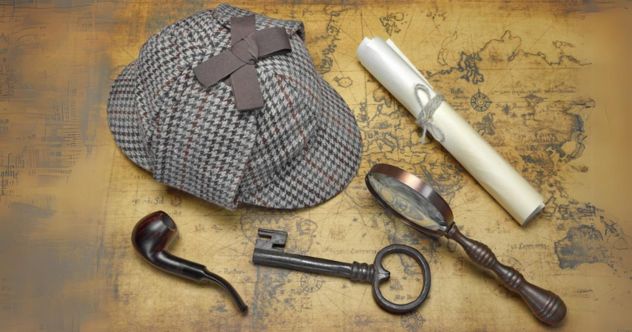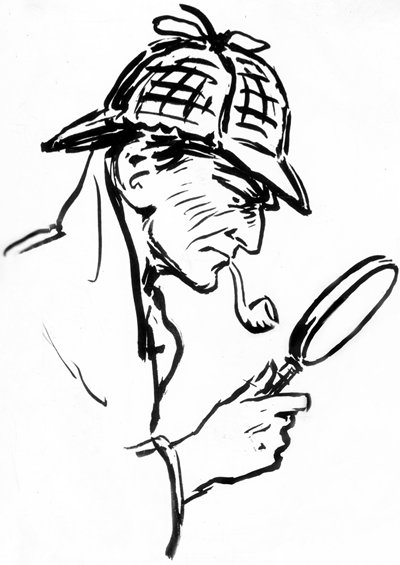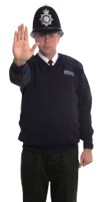
Think about the following questions.
1. Do you like detective stories? Why or why not?
2. Have you read any Sherlock Holmes short stories or novels? If so, what did you think?
3. Who are the most famous fictional characters in your culture? Do you know whether these characters are based on real people?
VOCABULARY PREVIEW
Match each New Academic Word List(NAWL) word with the correct definition.
- supposedly _____
- accent _____
- surgeon _____
- clever _____
- candidate _____
- correlation _____
- a. a doctor who performs operations
- b. quick-witted; smart
- c. an applicant or possible choice for a position
- d. a relationship or connection between two or more things
- e. according to a particular source, often unverified
- f. a way of pronouncing words that is specific to a certain group
MANCHESTER'S SHERLOCK HOLMES

Outside 221b Baker Street, London, a plaque1 proclaims Sherlock Holmes once lived there. According to local lore, many foreign tourists visit the site-which happens to be the Sherlock Holmes Museum- apparently unaware that the world's most famous Briton is a fictional character.
In fact, there was no such address when Sir Arthur Conan Doyle wrote his detective stories. (It was added when Baker Street was extended in the 1930s.) And accounts of droves of adoring but supposedly ignorant fans are also suspect. But such stories—and the canon of Holmes fiction that expands to this day-speak to the appeal of the character. Now, one author claims, there is evidence Doyle based Holmes on a real police detective: Jerome Caminada, known in his own time as "the Sherlock Holmes of Manchester."
Angela Buckley is the author of the 2014 book The Real Sherlock Holmes: The Hidden Story of Jerome Caminada. In it, she examines Manchester detective Caminada's autobiography and Doyle's work to draw comparisons between the real detective-active around the time Doyle created Holmes- and the fictional sleuth2. “There are so many parallels," she concludes, "that it is clear Doyle was using parts of this real character for his." Chief among these similarities, Buckley asserts, is intellect3. Doyle's fiction hinged on Holmes' almost superhuman powers of deductive reasoning and observation. Caminada, Buckley reports, could identify a career criminal by his walk and had an “encyclopedic knowledge" of the criminal underworld.
As with Holmes, Caminada was a master of disguise. Holmes goes undercover in many stories, as an Italian priest, a sailor, and an opium addict, among many examples. On real cases, Caminada dressed as a drunkard, a laborer, and even an upper-class professional, imitating the accents of each in order to gather information and apprehend suspects.
Buckley goes on to draw parallels between Caminada's real cases and the fictional capers Holmes solves. Like Holmes, she explains, Caminada apprehended an alluring femme fatale and had a brilliant arch-nemesis. The two were also formidable4 fighters in spite of their modest stature5.
Is the case closed? Did Doyle in fact base Holmes on Caminada? Going straight to the source, Doyle very clearly identified the medical professor Dr. Joseph Bell as his inspiration for Holmes. Bell was renowned6 for his keen powers of reasoning in medical diagnoses. Doyle biographers have also suggested development of the character may have been influenced by Sir Henry Littlejohn, an acquaintance who was a forensic surgeon with intimate knowledge of hundreds of criminal investigations.
Much of Buckley's premise rests on timing. Caminada had risen to national prominence, she argues, when Doyle was developing Sherlock Holmes. But so had other detectives, such as Leicester's Francis "Tanky" Smith, also known for clever disguises and for his vast knowledge of the criminal world. Even if there were only one candidate who fit the bill7, this leaves the question of why Doyle would not credit a detective who inspired him, despite being perfectly willing to credit a physician.
Furthermore, most of Buckley's work is based on unverified8 accounts from Jerome Caminada's autobiography, published fifteen years after the first appearance of Sherlock Holmes. One reviewer has pointed out some contemporary police detectives resented Doyle's portrayals of them as mediocre9. Did Caminada use his book to show that real police were better than that? We cannot be sure, but it is safe to say he had clear motives to present himself in a flattering light.
This brings us to the modern author and, apparently, the only proponent of the Caminada theory. Although she bills herself as a “family historian,” Buckley is, in fact, a genealogist10 and has no academic background in history. She may be faulted for failing to verify claims from a single source—an autobiography at that— and for basing her claims on loose correlations. But no one can prove she is wrong, either. The question may be destined to remain a mystery.
New Academic Word List
- plaque 1 : n. a flat, thin piece of wood or metal with writing on it used as reminder of something such as a historic event
- sleuth 2 : n. a detective
- intellect3 : n. the power of rational or intelligent thought
- formidable 4 : adj. very powerful or strong; deserving respect
- stature 5 : n. height
- renowned 6 : adj. famous
- fit the bill 7 : idiom. to have the required characteristics
- unverified 8 : adj. not proven or checked for accuracy
- mediocre 9 : adj. not very good
- genealogist10 : n. a person who traces or studies the descent of persons or families
READING COMPREHENSION
A ‣ Mark each statement as true (T) or false (F) according to the reading.
- Sherlock Holmes actually lived in the building at 221b Baker Street.
- True
- False
- Sir Arthur Conan Doyle and Jerome Caminada were real-life rivals.
- True
- False
- Buckley's book identifies Caminada as a highly intelligent man.
- True
- False
- Caminada published his autobiography before the first Sherlock Holmes story was written.
- True
- False
- Buckley's claims have been neither proven nor disproven.
- True
- False
B ‣ Choose the best answer according to the reading.
- What is the reading mainly about?
- a. The remarkable career of detective Jerome Caminada
- b. An evaluation of the central claims in Angela Buckley's book
- c. The uncanny similarities between a real and a fictional detective
- d. A summary of Sir Arthur Conan Doyle's Sherlock Holmes stories
- The word apprehend in paragraph 4 is closest in meaning to _____.
- a. understand
- b. notice
- c. escape
- d. catch
- The phrase The two in paragraph 5 refers to _____.
- a. Buckley and Doyle
- b. Holmes and Caminada
- c. Holmes and his nemesis
- d. Caminada and his femme fatale
- Which of the following is NOT stated about Angela Buckley?
- a. She has a degree in 19th-century history.
- b. She studies people's family backgrounds.
- c. She is the sole advocate of the Caminada theory.
- d. She has made claims based on one source.
C ‣ Find the correct numbers in the reading and write them on the lines.
- Today 221b Baker Street is the address of the _____.
- _____ is the only person Doyle specifically identified as an inspiration for Sherlock Holmes.
- _____ was a Leicester detective who used disguises and knew a lot about criminals.
SUMMARY
Fill in the blanks with the phrases in the box.
- disguised himself
- knew a surgeon
- formidable opponents
- deductive reasoning
- a genealogist
- unverified accounts
|
Cultural Differences
|
Biological Differences
|
VOCABULARY PRACTICE
Fill in the blanks with the words in the box. Change the form if necessary.
- accent
- candidate
- clever
- correlation
- supposedly
- surgeon
- The different regional _____ that people have can tell you which part of the country they are from.
- The _____ says that her hands are her most important tool.
- Comedians often have to come up with _____ responses to people who shout at them from the audience.
- A(n) _____ between a health problem and a certain product does not prove the product is causing the problem.
- Santa Claus _____ has flying reindeer and can visit every home on Earth in a single night, but that's just not possible.
- Although there are ten qualified _____ , there are only five jobs available.
SUPPLEMENTAL READING
"Peelers" and "Bobbies"

The British are generally perceived as a polite and civilized people, especially now that the sun has finally set on the Empire. This is partly a result of Victorian concerns about manners and propriety, which raises the question of what caused those concerns. A look at 18th-century London provides an answer. With no organized police force and with public manners, morals, and a violent-crime rate that were shocking by today's standards, London of this era resembled the Wild West; it was chaos. And this was a problem.
By the early 19th century, Londoners were fed up with crime. In 1829, just two years after Queen Victoria's coronation, the statesman Sir Robert Peel was tasked with establishing London's first organized, citywide police force, with headquarters at Scotland Yard. As he took personal responsibility for their performance, the populace associated officers closely with Robert (or "Bob" for short) Peel. Hence the terms "Peelers" and "Bobbies"—slang for police officers in Ireland and England, respectively.
Peel's police force was based on successful military units with civil-policing duties. And Peel introduced several concepts that are central to modern policing. These "Peelian Principles" essentially established the "serve and protect" standard. Peel believed a police force should maintain law and order, but in service of the public and with their consent and cooperation. The use of force was a last resort, and Peel expected his men to earn respect through devotion to duty and proper conduct. By all accounts, the Bobbies did indeed help restore order. And although much has changed in policing, the basic call to protect citizens rather than control them remains central to the mission of the department to this day.
Fill in the blanks with information from the reading.
- London in the 18th century had a shockingly high rate of _____ .
- "Peelers" is the slang word for police officers in _____ .
- The "Peelian Principles" mean that police should maintain law and order with the public's _____ .

Leave a comment
Load more